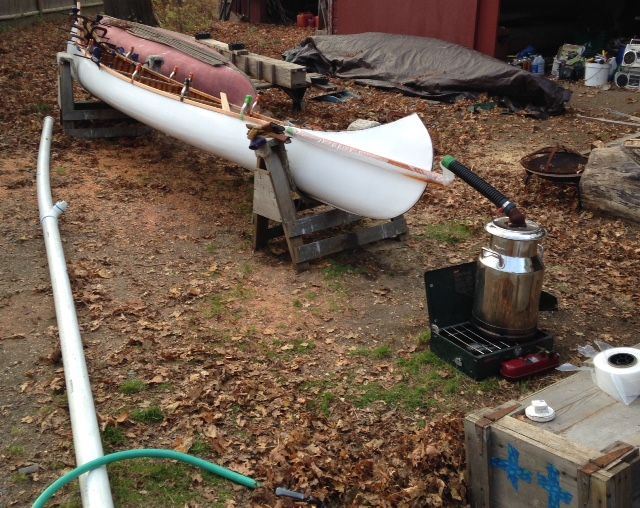G
Guest
Guest
Doug, I am vicariously enjoying your travails with fitting the rabbeted gunwales on the Rob Roy.
Gawd knows how those short gunwales were bent into place and installed OEM in the factory. I’d love to hear a Charlie Wilson description; there must be some secret technique.
The shorter length of the wales certainly eliminates some gentle bend leverage; trying to achieve that curve and sweep with a 17 foot length of ash is easier than forcing a 6 foot piece.
But I think another issue may have been the age and dryness of the “new” gunwale materials. Those were replacement wood gunwales a previous owner had purchased for a Malecite, and between when they were milled, sat at MRC, shipped to the original purchaser and sat with you I expect the moisture content was as low as it was going to get.
I have been trying to convince you that wood floats for several years. See past conversations about the effectiveness of “DIY rudders. . . made of wood”.
Stick a length of dowel in the PVC pipe and force the gunwales to remain fully submerged for the next set. I need to think of some package I can mail you with a “WOOD FLOAT DUMBASS” label.
To be fair I prefaced any concern raised or comment made with “I don’t know nothing about this, but. . . “.
Today my total knowledge of soak bending wood gunwales comes from DougD. I won’t be adding that notation to my resume.
So, asking the folks who have done this, how long will it take for the gunwales to “dry out” and hold their curved shape, assuming Doug’s New Hampshire winter temperatures?
Gawd knows how those short gunwales were bent into place and installed OEM in the factory. I’d love to hear a Charlie Wilson description; there must be some secret technique.
The shorter length of the wales certainly eliminates some gentle bend leverage; trying to achieve that curve and sweep with a 17 foot length of ash is easier than forcing a 6 foot piece.
But I think another issue may have been the age and dryness of the “new” gunwale materials. Those were replacement wood gunwales a previous owner had purchased for a Malecite, and between when they were milled, sat at MRC, shipped to the original purchaser and sat with you I expect the moisture content was as low as it was going to get.
I brought my the PVC pipe down with the soaking wood and literally had to tap the top cap off. To my dismay the wood had floated up so the last 3" or so were dry, oh yeah dumbass wood floats!,
I have been trying to convince you that wood floats for several years. See past conversations about the effectiveness of “DIY rudders. . . made of wood”.
Stick a length of dowel in the PVC pipe and force the gunwales to remain fully submerged for the next set. I need to think of some package I can mail you with a “WOOD FLOAT DUMBASS” label.
During a dry fit on the hull these gunwales creaked like a SOB and I thought they break but this time they just bent without any protest. Sweet! After talking with Mr. McCrea, who knows as little about this as I do, the topic of wood drying and twisting came into play.
To be fair I prefaced any concern raised or comment made with “I don’t know nothing about this, but. . . “.
Today my total knowledge of soak bending wood gunwales comes from DougD. I won’t be adding that notation to my resume.
So now it's just a waiting game of drying out and the wood holding memory and keep the fingers crossed it works.
So, asking the folks who have done this, how long will it take for the gunwales to “dry out” and hold their curved shape, assuming Doug’s New Hampshire winter temperatures?

